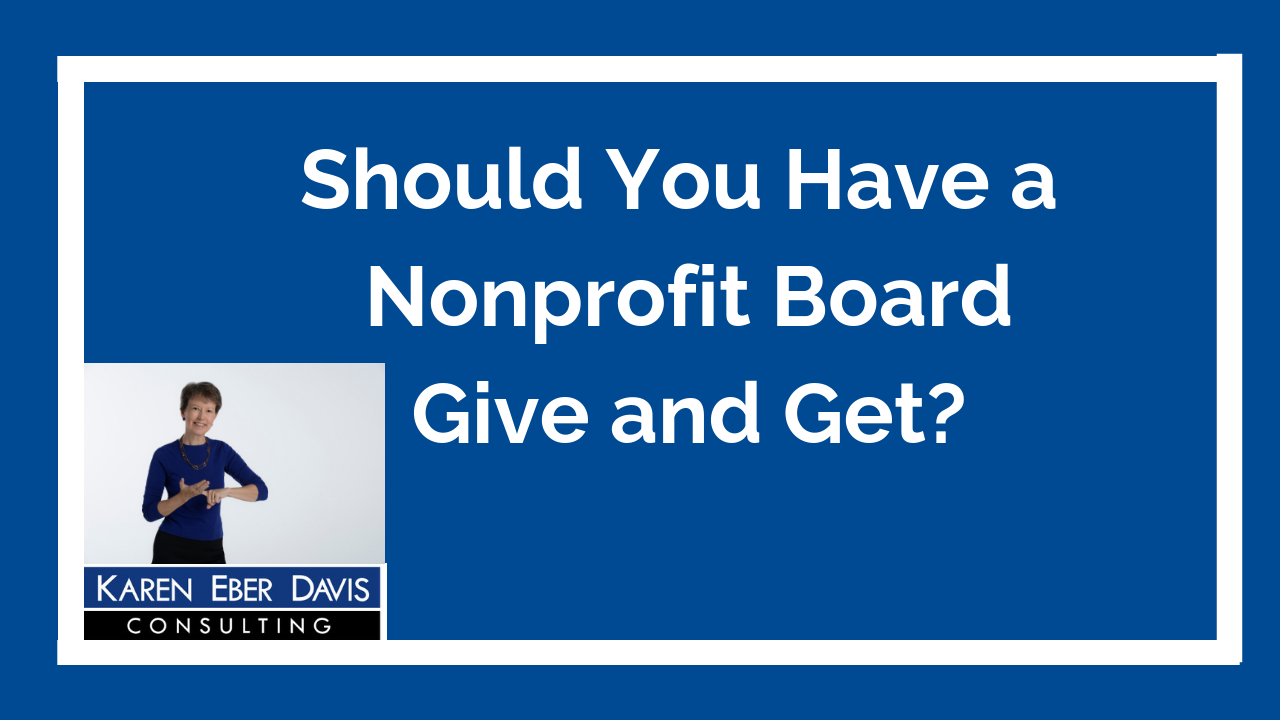
Should You Have a Board Give and Get?
Listen to this video to hear the answers to the following essential questions: Across the industry what is the average nonprofit give or get? Why is board giving a must? Should you have an exact number that you expect board members to provide? Might you offer a range? What is a sacrificial gift? Moreover, what does board giving have to do with major gifts?
For more answers, check out the Nonprofit CEO Library.
For solutions delivered to your inbox sign up for Karen’s CEO Solutions.
Transcript for Should Your Board Have a Give or Get
Hi, I’m Karen Eber Davis. Welcome to Added Value Video. Let’s talk about asking board members to give or get as part of their requirements. Many organizations do that. In fact, when the research was done a number of years ago, the average gift was $150, and the good news is that boards are giving more and more. And more and more boards are giving a hundred percent which is a standard in the industry. And it’s a must-do because other people, like donors, want to know, Does the board give? And if the board is not giving, they can choose to go somewhere else. Because if the board doesn’t believe in the nonprofit enough to put their money in, why should someone who’s on the outside and less intimately knowledgeable about the organization do so? It cast doubts. So board member giving is a must. And the question. “Is it helpful to have a number?” I find what’s helpful is to give board members a range. And that range is what the historic giving has been say in the last year less the lowest gifts because you want to move people up if you can. And tell them that. And then ask them to give a sacrificial gift, something that would challenge them. And part of that challenge, that definition is actually one of the largest three gifts they give to any nonprofit. So you’re amongst the top people in their giving in any given year. Now in terms of setting a number, I would turn that to my board. This is a board peer-to-peer relationship board to decide since it’s being given by them how it should be treated. Should there be a give or get? Should there be a number? Should there be a range? Lots of options, but that’s something the board should talk about together because, again, you are in a position of supporting what their work is, and they have to determine how to best support the nonprofit. Obviously it needs to be a gift because it’s expected by other people coming to the nonprofit, but what that should be should be a board’s decision.
So having said all that, I would challenge the board to at least give cumulatively what would equal a major gift in your organization. If you’ve already achieved that level, then multiples of that because as you plan your budget, you know that you have a major gift coming of unrestricted funds that will be very helpful to meet your budget. So a major gift is always determined by an organization. It’s individual for each organization. So your major gift may be $1,000, and if we don’t, your board reaches for, or your board’s major gift may be $20,000. And that’s what your board reaches for once they’ve reached that, you encourage them to reach multiples of it, so we have two major gifts from the board, and that allows you also as you start the New Year and say it’s “great news we’ve already received a major gift.”
So I’m Karen Eber Davis. There’s lots more in other Added Value Videos about working with boards, and please send in your questions.
Karen Eber Davis provides customized advising and coaching around nonprofit strategy and board development. People leaders hire her to bring clarity to sticky situations, break through barriers that seem insurmountable, and align people for better futures. She is the author of 7 Nonprofit Income Streams and Let's Raise Nonprofit Millions Together.
Categories
If you appreciate these Added Value posts, please consider subscribing.
By submitting this form, you are consenting to receive marketing emails from: Karen Eber Davis Consulting. You can revoke your consent to receive emails at any time by using the SafeUnsubscribe® link, found at the bottom of every email. Emails are serviced by Constant Contact
Latest Posts
- Como o Blaze Casino Cativa Jogadores Brasileiros: Jogos, Bônus e Mais
- Descubre el Mundo de las Apuestas Betano en México: Una Guía Completa
- Empieza a Ganar con €20 Gratis Sin Depósito en Casinos Online
- Inicia tu Aventura de Juego con Bonos Gratis sin Depósito en México
- La experiencia completa de apuestas en Yajuego para el aficionado colombiano
- Playdoit: Donde las Apuestas y la Diversión se Fusionan en México
- Stake Casino Canada: Understanding Legal and Safe Online Betting
- The Ultimate Zodiac Casino Canada Review by Experts
